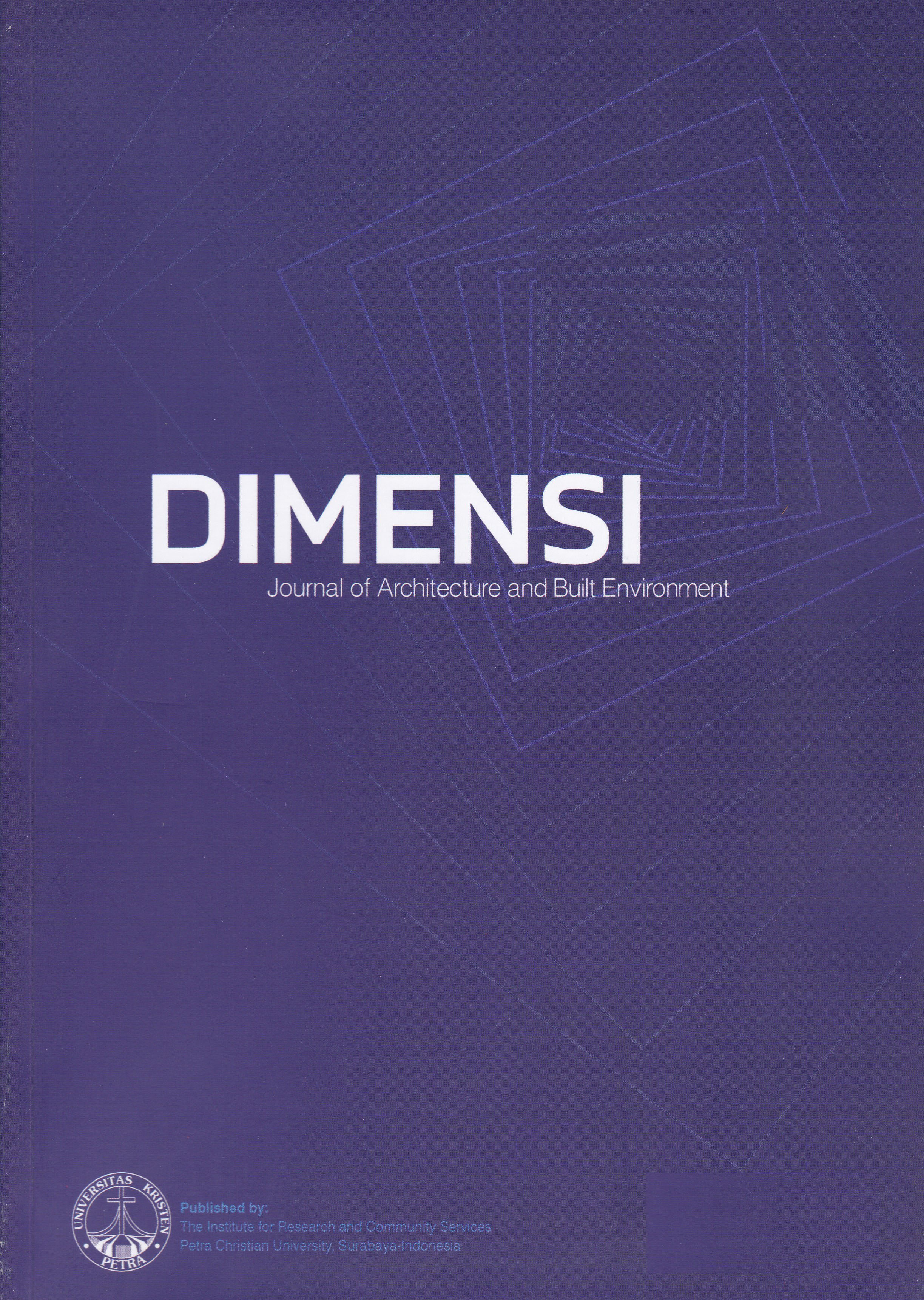AUTHENTICITY IN BUILDING ADJUSTMENT SIMULATION (Case Study: Emergency Room of St. Elizabeth Hospital Semarang, Indonesia)
 :
:
https://doi.org/10.9744/dimensi.48.1.19-28
Keywords:
Sustainability, Hospital, Heritage Building, DesignAbstract
This paper aims to simulate adjustments for new functions in hospitals that respect the authenticity of cultural heritage buildings. The development of heritage buildings should be integrated, especially in adjusting building functions, such as room arrangement. The emergency room is a vital function for hospital services, and consideration is needed to arrange procedures. The research method chosen in this research is descriptive qualitative with a case study in the Magdalena Daeman building St Elizabeth Hospital. Design simulation can be realized by adjusting the standard emergency room requirements into the layout of the building. Additionally, cultural heritage buildings should be maintained to be used in operational functions by carrying out development. This study's results can be a guideline in developing new functions of cultural heritage buildings that meet the conservation technique guidelines.
Downloads
References
British Museum. (2020). Retrieved from blog.british-museum.org on 1 June 2021
Cherchi, P. F. (2015). Adaptive Reuse of Abandoned Monumental Buildings as a Strategy for Urban Liveability. Athens Journal of Architecture, 1(4), 253–270. https://doi.org/10.30958/aja.1-4-1
Elsorady, D. A. (2020). Adaptive Reuse Decision Making of a Heritage Building Antoniadis Palace, Egypt. International Journal of Architectural Heritage, 14(5), 658–677. https://doi.org/ 10.1080/15583058.2018.1558313
Fournier, F. D., & Zimnicki, K. (2004). Integrating Sustainable Design Principles into the Adaptive Reuse of Historical Properties. Washington, DC: Construction Engineering Research Laboratory, 1-60
Hasan, H. S. M., Wahab, L. A., & Ismail, D. (2017). A Review of Authenticity in Adaptive Reuse of Heritage Buildings in. Proceedings of Inter¬national Conference on Architecture 2017 (ICRP-AVAN), 2017(2016), 59–63.
Heritage Council of NSW. (2019). Design Guide for Heritage (02), 1–70.
Ijla, A., & Broström, T. (2015). The Sustainable Viability of Adaptive Reuse of Historic Buildings : the experiences of Two World Heritage Old Cities ; Bethlehem in Palestine and Visby in Sweden. 2(4), 52–66.
Jeong, T. J. (2019). Sustainable use of cultural heritage in the formation of healing environments: A case study of a healthcare facility on a historic urban site. Sustainability (Switzerland), 11(7). https://doi.org/10.3390/su11071866
Li, Y., Zhao, L., Huang, J., & Law, A. (2021). Research frameworks, methodologies, and assess¬ment methods concerning the adaptive reuse of architectural heritage: a review. Built Heritage, 5(1). https://doi.org/10.1186/s43238-021-00025-x
Logan, C., Goad, P., Willis, J., Logan, C., & Goad, P. (2010). Modern hospitals as historic places Modern hospitals as historic places. 2365. https://doi.org/10.1080/13602365.2010.519952
Mohd Abdullah, M. S., Suratkon, A., & Syed Mohamad, S. B. H. (2020). Criteria for adaptive reuse of heritage shop houses towards sustainable urban development. International Journal of Sustainable Construction Engineering and Technology, 11(1), 42–52. https://doi.org/10. 30880/ijscet.2020.11.01.005
Nagasawa, Y. (2020). Global Hospitals in 2050 — A review of the historical development of hospital building studies from a global perspective. 3(1). https://doi.org/10.1002/2475-8876.12131
NSW, H. C. (2005). Design in Context: Guidelines for Infill Development in the Historic Environ¬ment, NSW Heritage Office & Royal Australian Institute of Architects NSW Chapter.
Pilosof, N. P., & Ii, M. (2020). Building for Change : Comparative Case Study of Hospital Architec-ture. 1–14. https://doi.org/10.1177/1937586720 927026
Purwanto, U., & Soliha, E. (2017). Influence of City Branding, Brand Identity and Brand Image on Visiting Decision To Kota Pekalongan. Jurnal Bisnis Dan Manajemen, 18(02), 34–45. https://doi.org/10.24198/jbm.v18i1.40
Regulation Number 28 year 2002
Regulation number 5 year 1992
Sakallaris, B. R., Macallister, L., Voss, M., Smith, K., & Jonas, W. (2015). Optimal healing environ¬ments. 40–45. https://doi.org/10.7453/gahmj. 2015.043
Samadzadehyazdi, S., Ansari, M., Mahdavinejad, M., & Bemaninan, M. (2020). Significance of authenticity: learning from best practice of adaptive reuse in the industrial heritage of Iran. International Journal of Architectural Heritage, 14(3), 329–344. https://doi.org/10.1080/155830 58.2018.1542466
Son, J. H., & Yang, N. W. (2012). A Study on characteristics of considering healing environmental concept in domestic healthcare architectures schematic design—Focusing on the prizewinner of healthcare architecture design competition since 2000. Arch. Res., (28), 125–132.
Tausky, N. Z. (2011). Cultural Heritage Assessment : Buildings In The South Street Hospital Complex London, Ontario.
Theodore, D. (2016). Better design, better hospitals. https://doi.org/DOI:10.1503/cmaj.151228
Truscott, M. C. (2014). Burra Charter: The Australia ICOMOS Charter for Places of Cultural Signifi-cance (1999). Encyclopedia of Global Archaeology, 1078–1082. https://doi.org/10.1007/978-1-4419-0465-2_1046
UNEP. (2009). Buildings and Climate Change: Summary for Decision-Makers. UNEP publications.
Yazdani Mehr, S., & Wilkinson, S. (2020). The importance of place and authenticity in adaptive reuse of heritage buildings. International Journal of Building Pathology and Adaptation, 38(5), 689–701. https://doi.org/10.1108/IJBPA-01-2020-0005
Downloads
Published
How to Cite
Issue
Section
License
Authors who publish with this journal agree to the following terms:
- Authors retain copyright and grant the journal right of first publication with the work simultaneously licensed under a Creative Commons Attribution License that allows others to share the work with an acknowledgement of the work's authorship and initial publication in this journal.
- Authors are able to enter into separate, additional contractual arrangements for the non-exclusive distribution of the journal's published version of the work (e.g., post it to an institutional repository or publish it in a book), with an acknowledgement of its initial publication in this journal.
- Authors are permitted and encouraged to post their work online (e.g., in institutional repositories or on their website) prior to and during the submission process, as it can lead to productive exchanges, as well as earlier and greater citation of published work (See The Effect of Open Access).


















